Key takeaways:
- Community housing development emphasizes creating belonging and stability, focusing on the needs of local residents.
- Engaging in open dialogues fosters trust, empowerment, and collaboration among diverse community members.
- Facilitating discussions with a clear purpose and inclusive atmosphere encourages participation and innovative ideas.
- Empathy, active listening, and humor can transform tense dialogues into constructive conversations.
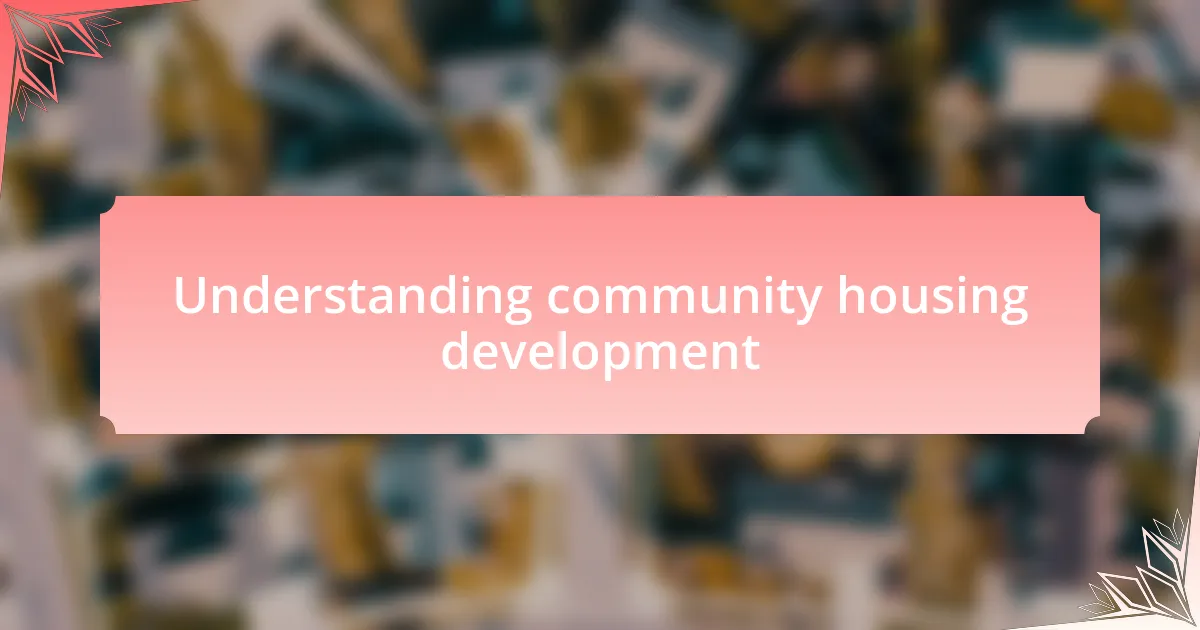
Understanding community housing development
Community housing development is more than just building homes; it’s about creating a sense of belonging. I remember when our town first began exploring this initiative. The excitement was palpable, but so were the fears and uncertainties. How would this impact our community? That curiosity drove many of us to engage and understand the process, making it crucial to recognize that community housing is a collaborative effort, deeply rooted in the needs and desires of local residents.
At its core, community housing development focuses on providing accessible and affordable living options. I once attended a meeting where a single mother shared her struggle to find a suitable place for her family. She stood up and spoke with such vulnerability, capturing everyone’s attention. It hit me then how vital these developments are—not just as structures but as sources of hope and stability for individuals facing financial hardships. By focusing on what the community needs, we can foster environments that support both the physical and emotional well-being of residents.
Understanding community housing also requires acknowledging the diverse perspectives within our neighborhoods. I’ve seen firsthand how discussions can unite us, as different voices contribute valuable insights. I often ponder: how can we ensure that each community member feels heard? This ongoing dialogue is essential for shaping developments that resonate with the fabric of our town, enhancing not just the housing landscape but also the community ties that bind us together.
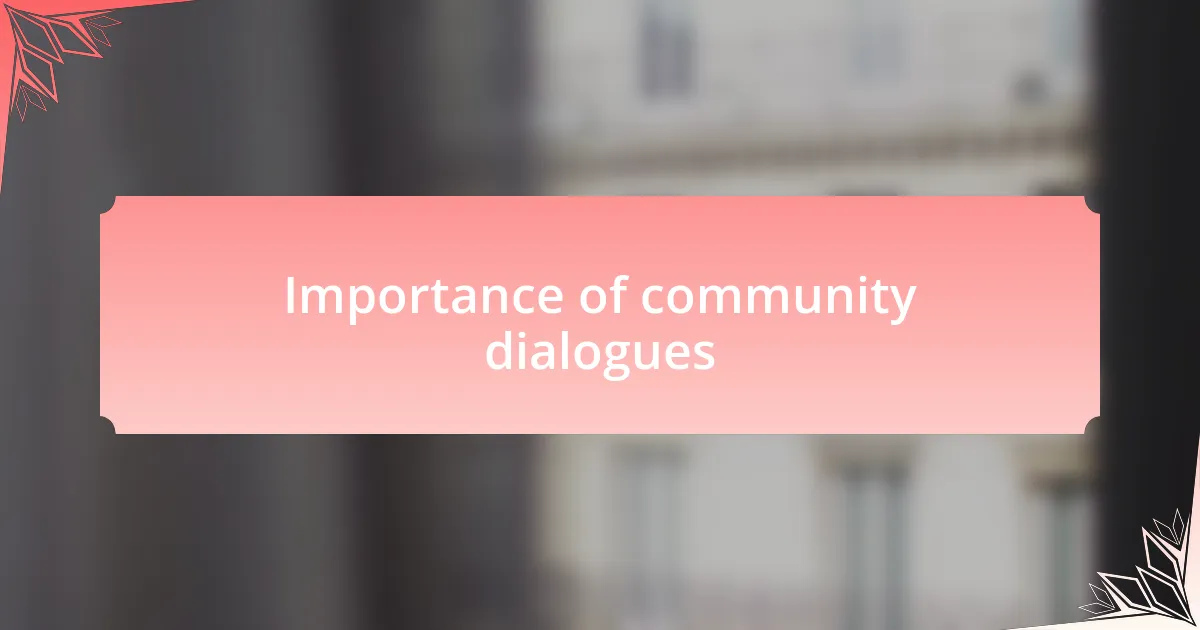
Importance of community dialogues
Engaging in community dialogues is essential for fostering trust and collaboration among residents. I remember a neighborhood meeting where tensions ran high over a proposed housing project. As we shared our thoughts and feelings, it became clear—people just wanted to be heard. This open exchange helped us navigate conflicting ideas and ultimately led to a solution that satisfied most. It reminded me that dialogue isn’t just about talking; it’s about building relationships that enable us to move forward together.
Moreover, these conversations create opportunities for empowerment within the community. I’ve seen how a simple dialogue can inspire individuals to take initiative and advocate for their needs. At one gathering, a resident voiced concerns about accessibility for seniors. That sparked a chain reaction—others joined in, leading to actionable steps that improved our housing plans. This experience taught me that when we listen, we empower others to participate actively, ensuring that the development truly reflects the community’s aspirations.
Finally, community dialogues serve as a platform for education and awareness. I’ve noticed that many residents are unaware of the resources available to them. During one discussion, we unveiled local aid programs and support services, transforming misconceptions into a shared understanding. This collective learning experience not only enriched our dialogues but also fostered a greater sense of responsibility towards one another. Isn’t it incredible how information shared in these settings can spark collective action and ultimately improve lives?
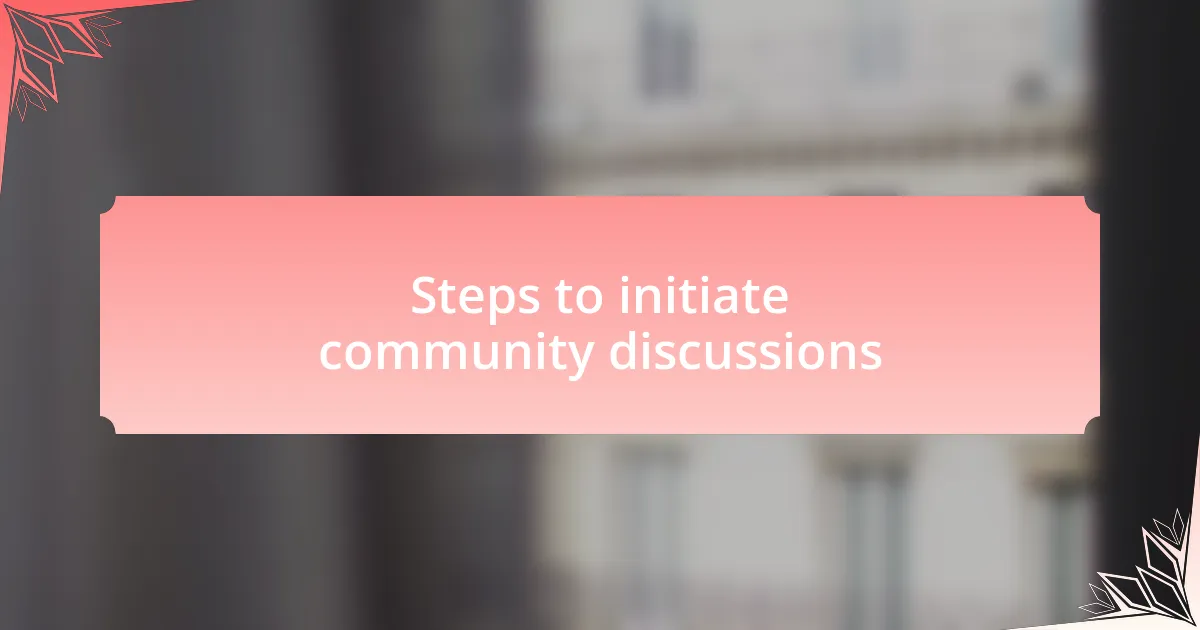
Steps to initiate community discussions
To initiate community discussions effectively, I found that starting with a clear purpose really sets the tone. When I organized our first meeting, I made sure to explain why we were getting together— addressing local housing issues. I shared a personal story about how a neighbor almost lost their home due to misunderstandings and fear. This connection not only humanized the discussion but sparked genuine interest in solutions.
Next, I discovered the importance of inviting diverse voices. The moment I included not just homeowners, but renters, seniors, and even local businesses, the dialogues transformed. I still remember a passionate exchange between a young artist and an elderly resident about how space can be utilized for community art. It was these different perspectives that enriched our conversations, leading to innovative ideas. Have you ever noticed how a fresh point of view can completely change the direction of a discussion?
Finally, I always encouraged a welcoming atmosphere where everyone felt comfortable sharing. I recall a meeting where we set up the chairs in a circle. It naturally promoted openness and made it easier for people to connect. By acknowledging each person’s contribution, whether small or large, I noticed an increase in participation. Isn’t it amazing how fostering inclusivity can bring out the best in a community?
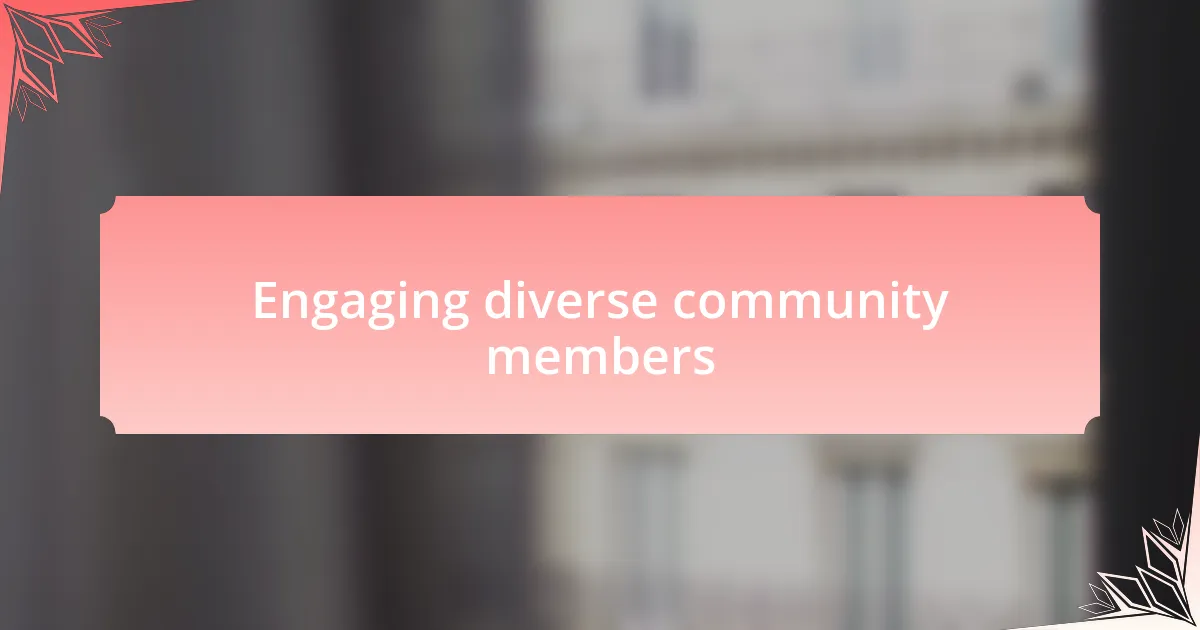
Engaging diverse community members
Engaging diverse community members required me to step out of my comfort zone and actively seek out those who often went unheard. I remember visiting a local community center, where the youth gathered while their grandparents chatted in the corner. By bridging the gap between these two groups, I initiated conversations that revealed shared concerns over neighborhood safety and access to resources. Have you ever witnessed how powerful it is when different generations share their experiences? It was enlightening to see how they could learn from each other.
I found that language and cultural differences could be significant barriers to engagement. During one event, I met a refugee family who felt isolated because they didn’t speak the local language well. Instead of letting this discourage them, I invited bilingual community members to help translate. This simple act not only brought more voices into the discussions but also built friendships. When was the last time you reached out beyond your familiar circles? I learned that making an extra effort to connect is often the key to unlocking rich dialogues.
Equally important was creating activities that encouraged participation from everyone. In one memorable workshop, we used art supplies to facilitate brainstorming on housing solutions. I watched in amazement as residents of all ages and backgrounds collaborated on colorful posters. The joy in their eyes as they contributed ideas was infectious—how therapeutic it can be to express thoughts visually! These moments illustrated that when we engage a diverse group, we unlock creativity and solutions that resonate across the entire community.
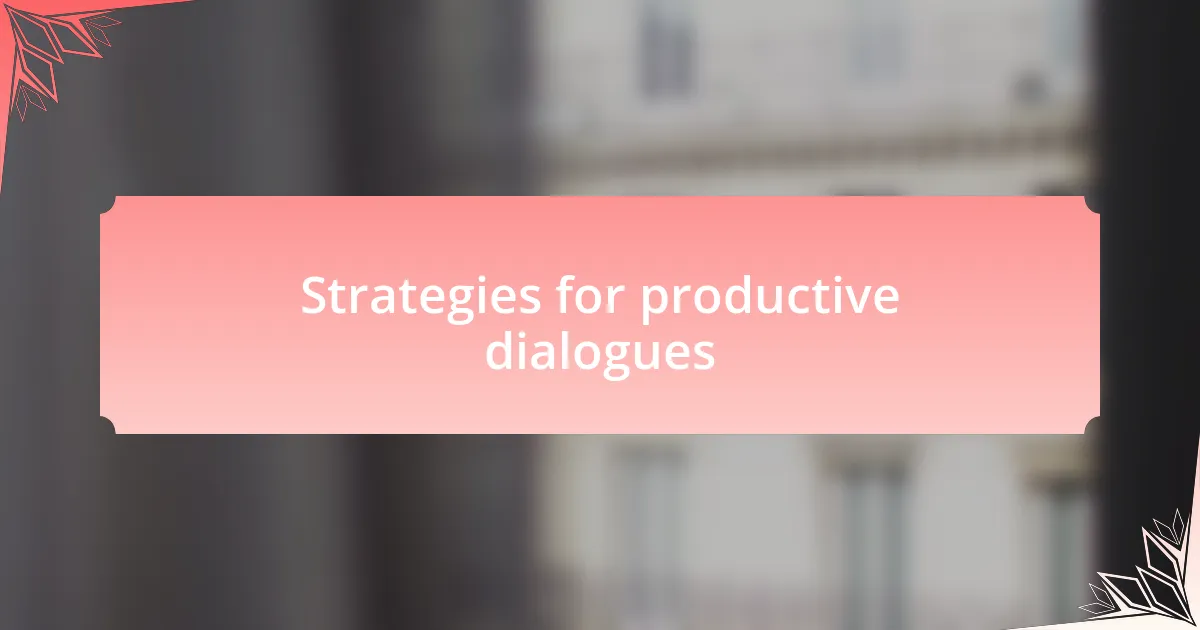
Strategies for productive dialogues
When facilitating productive dialogues, I found that establishing a safe and inclusive environment was crucial. I remember organizing an open forum where community members could voice their ideas without fear of judgment. As I watched individuals who typically sat silently in meetings step forward, I realized that this safe space encouraged honesty and vulnerability. How often do we create spaces that genuinely invite open sharing?
Another effective strategy was to use focused prompts to guide discussions. During one session focused on housing needs, I posed the question, “What does an ideal neighborhood look like to you?” The responses were diverse, reflecting varied hopes and challenges. It struck me how guiding the conversation with targeted prompts can elevate the dialogue from surface-level chatter to deeper, significant exchanges. What questions could reshape your conversations to be more meaningful?
Finally, actively listening made all the difference in ensuring that everyone felt heard. I recall a moment when a quiet elder shared her story about housing struggles, and I made sure to pause, reflect, and respond thoughtfully. This approach not only validated her feelings but also encouraged others to speak out. It reminded me that sometimes, just listening can be the most powerful tool in dialogue. How can we cultivate more of this attentive listening in our daily conversations?
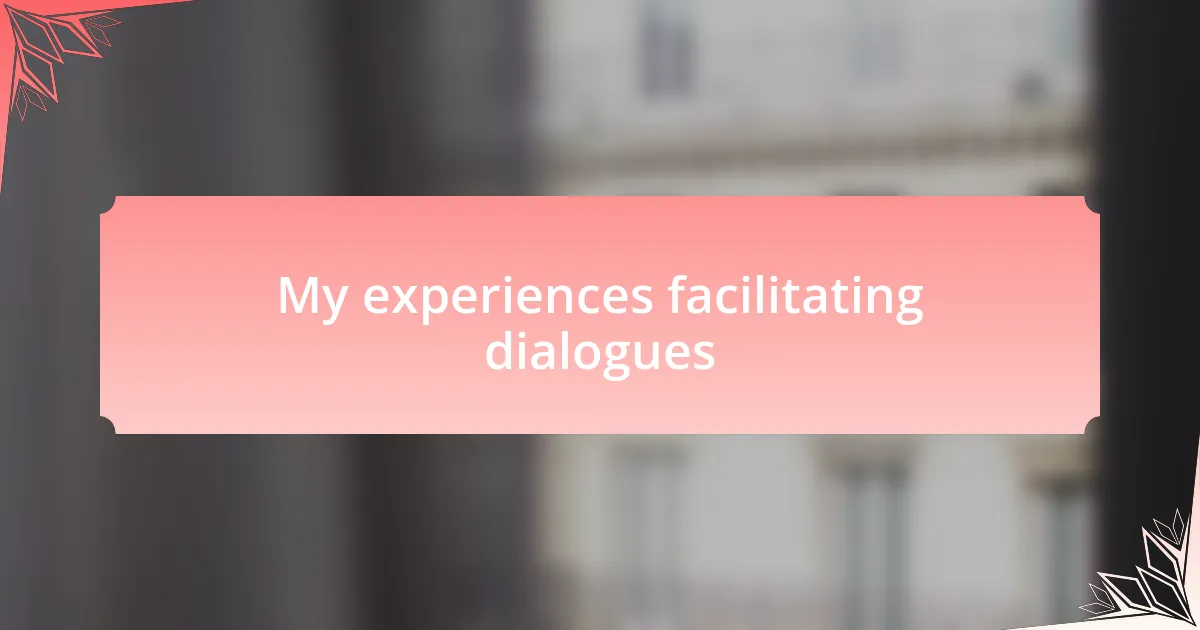
My experiences facilitating dialogues
Facilitating dialogues has been a transformative journey for me. I remember one particular meeting where tensions were high due to differing opinions about a new housing project. As I gently navigated the discussion with empathy and understanding, I could see the participants gradually soften. It made me reflect on how powerful it can be to create space for empathy; how often do we let our differences strengthen our community rather than divide it?
In another instance, I facilitated a dialogue focusing on the impact of gentrification in our town. One participant shared a heartfelt story about their childhood neighborhood being reshaped into a different landscape. In that moment, I felt the weight of her words; it wasn’t just about housing— it was about identity and belonging. This experience reiterated to me that conversations can bridge personal stories with broader community issues. Have you ever felt the pulse of a community shift through shared stories?
Lastly, I discovered that humor can be an effective tool in easing tensions. During a particularly heated discussion, I made a light-hearted comment about how all of us have debated the best pizza in town. It brought a moment of laughter and reminded everyone that we’re all on the same team, even in disagreement. This small shift in atmosphere highlighted how a bit of levity can pave the way for more constructive conversation. Is there a fun shared experience you could leverage to bring your group closer together?